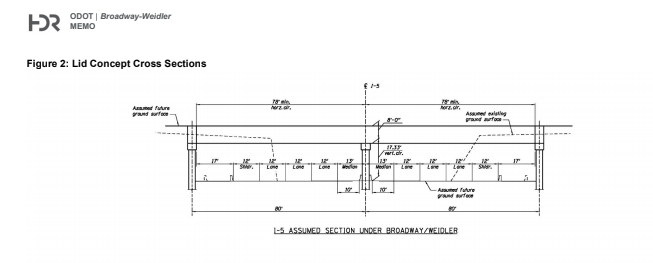Newly revealed documents show its roadway is vastly wider than needed for traffic, and also makes “buildable” freeway covers prohibitively expensive
If you really want just two additional lanes, you can do so much more cheaply and with less environmental destruction
The reality is ODOT is planning a 10 lane freeway at the Rose Quarter, and is lying about the covers and the project’s real cost and environmental impact
For years, the Oregon Department of Transportation has been lying about the freeway widening project it plans for a mile long stretch of I-5 at Portland’s Rose Quarter. While it’s advertised as just adding a couple of so-called “auxiliary” lanes, we and others have uncovered multiple documents showing that they’re actually planning a 150-foot to 160-foot roadway, wide enough for a ten lane freeway.
The latest confirmation of ODOT’s big lie comes from a report prepared by one of the agency’s own consultants, ARUP Associates ARUP pointed out the obvious: If you really want to just add two lanes to the existing 82 foot wide pavement, you certainly don’t need two double the size of the roadway. In an article published by Willamette Week, ARUP says:
“The most significant driver of project cost (initial construction cost as well as ongoing maintenance and life-cycle costs), right-of-way impacts, and development potential on and adjacent to the covers is the cross-section width,” the draft report states, laying out various technical approaches used in other states.”We believe these options can be considered to reduce the tunnel width so as to minimize construction cost and impact to the adjacent properties.”
The ARUP report shows the Rose Quarter project could be much smaller, cheaper, and less environmentally destructive. ARUP recommends interior shoulders of 3 to 8 feet (instead of 12); exterior shoulders of 10 feet (instead of 12), and lanes of 11 or 12 feet (instead of only 12).
ODOT claims that part of the reason for such a wide right of way is to accommodate “full” shoulders. But ARUP’s report puts the lie to that claim. It notes that nowhere in expensive urban freeway rebuilding projects does anyone build 12-foot inside shoulders. Willamette Week reports:
. . . no comparable highway project in any other city includes the 12-foot inner shoulder lanes that ODOT has included in this project. (According the report, Presidio Parkway in San Francisco has 4 feet, the I-93 Central Artery in Boston has zero feet, and the Alaskan Way tunnel in Seattle has 2 feet.)
Not only that, even for this project, ODOT doesn’t think 12-foot shoulders are necessary. On the project’s viaduct section, at the Southern end of the project, ODOT is proposing to add a freeway lane (including re-striping freeway lanes to 11 feet in width), and shoulders of 3 to 9 feet. ODOT’s own analysis shows these narrower shoulders and lanes have a trivial impact on safety compared to a wider and more expensive project.
As we’ve maintained for several years, the real reason ODOT is planning a massive roadway with oversized shoulders is because it plans to simply re-stripe the road for additional lanes as soon as the project is built, something that could be accomplished in an afternoon with a few gallons of highway paint. It’s a blatant attempt to evade any environmental analysis of the traffic, noise, air pollution, and greenhouse gas emissions that would be associated with building a 10 lane freeway, and is violation of the National Environmental Policy Act.
Blowing up the covers
ODOT has attempted to woke-wash this project by claiming that the construction of a highway cover (really slightly enlarged overpasses) will help repair the damage the original construction of Interstate 5 did to the Albina neighborhood in the 1960s and 1970s. While they’ve claimed that the covers might be used for a variety of purposes, their own consultants have concluded that the current project design creates a human- and pedestrian hostile environment that’s inimical to neighborhood restoration.
The new ARUP documents make it clear that the vastly oversized roadway also makes covers much more expensive, and and in particular, makes constructing covers that could support multi-story buildings prohibitively expensive. According to Willamette Week, project documents now show the covers construction could cost $500 million, and would cost an additional $200 million if build strong enough to support an 5-story building.
The draft Constructability and Cost Analysis Report for the Rose Quarter Independent Cover Assessment, dated June 2, estimates covering the highway would cost more than $500 million. Covers that could support five-story buildings would cost roughly $200 million more, depending on which design ODOT proceeds with.
The freeway covers have always been a transparent and disingenuous ploy to cloak this project as a vehicle of neighborhood restoration. ODOT has not committed any funds to real reparations, in particular rebuilding any of the hundreds of houses iti demolished for highway construction in the 1950s, 1960s and 1970s Other state highway departments have used highway funds to build housing to undo the damage of past freeway building projects, but not Oregon DOT. If it actually cared about restoring the neighborhood, ODOT would be talking about the narrowest possible freeway, and providing more money for housing and restoring the neighborhood. Or it could study removing the freeway entirely. All of the glib talk about covering a vastly wider freeway, is really just a fig leaf for a deeply flawed project.



